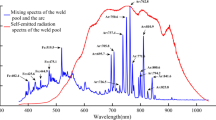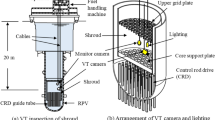Abstract
With the rapid development of welding automation, manual visual detection and manual measurement of weld appearance contour are gradually transitioning to automated detection. In this paper, a compound 3D vision system of projection structured light and shape from shading is constructed, which solves the problem that the current laser scanning vision method is not applicable in the occasions with high beat requirements. The projection structured light vision system is encoded by sinusoidal fringe to realize the high-precision 3D recovery of highly reflective metal surface. The shape from shading method can obtain the high-definition gradient information of the weak fluctuation of the weld surface and the Lambert reflection theorem in this method is used to solve the problem that the reflectivity is difficult to obtain. Using the above compound vision system, taking the weld of aluminum alloy variable polarity plasma arc (VPPA) welding as an example, the relevant image processing algorithm has been developed to accurately realize the measurement of contour size and the extraction of contour defects on the face and back of the weld. In view of the features that the 3D boundary features of face of weld in VPPA welding are not obvious, the shadow recovery shape method is used to obtain the gradient image of the metal surface. Combined with the fish scale information on the weld surface, the reliable extraction of the weld boundary is realized.






















Similar content being viewed by others
Availability of data and materials
All data generated or analysed during this study are included in this published article.
References
Praveen A, Vijayarekha K, Abraham ST, Venkatraman B (2013) Signal quality enhancement using higher order wavelets for ultrasonic TOFD signals from austenitic stainless steel welds. Ultrasonics 53:1288–1292. https://doi.org/10.1016/j.ultras.2013.03.013
Zeng W, Cai M, Wang P, Lu T, Yao F (2020) Application of laser ultrasonic technique for detecting weld defect based on FDST method. Optik (Stuttg) 221:165366. https://doi.org/10.1016/j.ijleo.2020.165366
Gao X, Li Y, Zhou X, Dai X, Zhang Y, You D, Zhang N (2020) Multidirectional magneto-optical imaging system for weld defects inspection. Opt Lasers Eng 124:105812. https://doi.org/10.1016/j.optlaseng.2019.105812
Li Y, Gao X, Zheng Q, Gao P, Zhang N (2019) Weld cracks nondestructive testing based on magneto-optical imaging under alternating magnetic field excitation. Sensors Actuators, A Phys 285:289–299. https://doi.org/10.1016/j.sna.2018.11.017
Valavanis I, Kosmopoulos D (2010) Multiclass defect detection and classification in weld radiographic images using geometric and texture features. Expert Syst Appl 37:7606–7614. https://doi.org/10.1016/j.eswa.2010.04.082
Yan ZH, Xu H, Huang PH (2020) Multi-scale multi-intensity defect detection in ray image of weld bead. NDT E Int 116. https://doi.org/10.1016/j.ndteint.2020.102342
Zhang Z, Yang Z, Ren W, Wen G (2019) Random forest-based real-time defect detection of Al alloy in robotic arc welding using optical spectrum. J Manuf Process 42:51–59. https://doi.org/10.1016/j.jmapro.2019.04.023
Bia ZM, Wang L (2010) Advances in 3D data acquisition and processing for industrial applications. Robot Comput Integr Manuf 26:403–413. https://doi.org/10.1016/j.rcim.2010.03.003
Yang J, Li S, Wang Z, Dong H, Wang J, Tang S (2020) Using deep learning to detect defects in manufacturing: a comprehensive survey and current challenges. Materials (Basel) 13:1–23. https://doi.org/10.3390/ma13245755
Jing O, Lai Z, Qinghong W, Xin L, YingJie L (2021) Weld-seam identification and model reconstruction of remanufacturing blade based on three-dimensional vision. Adv Eng Informatics 49:101300. https://doi.org/10.1016/j.aei.2021.101300
Jia N, Li Z, Ren J, Wang Y, Yang L (2019) A 3D reconstruction method based on grid laser and gray scale photo for visual inspection of welds. Opt Laser Technol 119:105648. https://doi.org/10.1016/j.optlastec.2019.105648
Yang L, Liu Y, Peng J, Liang Z (2020) A novel system for off-line 3D seam extraction and path planning based on point cloud segmentation for arc welding robot. Robot Comput Integr Manuf 64:101929. https://doi.org/10.1016/j.rcim.2019.101929
Yan Z, Shi B, Sun L, Xiao J (2020) Surface defect detection of aluminum alloy welds with 3D depth image and 2D gray image. Int J Adv Manuf Technol 110:741–752. https://doi.org/10.1007/s00170-020-05882-x
Han Y, Fan J, Yang X (2020) A structured light vision sensor for on-line weld bead measurement and weld quality inspection. Int J Adv Manuf Technol 106:2065–2078. https://doi.org/10.1007/s00170-019-04450-2
Chu HH, Wang ZY (2016) A vision-based system for post-welding quality measurement and defect detection. Int J Adv Manuf Technol 86:3007–3014. https://doi.org/10.1007/s00170-015-8334-1
Zong Y, Liang J, Wang H, Ren M, Zhang M, Li W, Lu W, Ye M (2021) An intelligent and automated 3D surface defect detection system for quantitative 3D estimation and feature classification of material surface defects. Opt Lasers Eng 144:106633. https://doi.org/10.1016/j.optlaseng.2021.106633
Gorthi SS, Rastogi P (2010) Fringe projection techniques: whither we are? Opt Lasers Eng 48:133–140. https://doi.org/10.1016/j.optlaseng.2009.09.001
Srinivasan V, Liu HC, Halioua M (1984) Automated phase-measuring profilometry of 3-D diffuse objects. Appl Opt 23:3105. https://doi.org/10.1364/ao.23.003105
Zhang S, Yau S-T (2006) High-resolution, real-time 3D absolute coordinate measurement based on a phase-shifting method. Opt Express 14:2644. https://doi.org/10.1364/oe.14.002644
Wang L, Song L, Zhong LJ, Xin P, Li S, Qi H (2013) Multi-frequency heterodyne phase shift technology in 3-D measurement. Adv Mater Res 774–776:1582–1585. https://doi.org/10.4028/www.scientific.net/AMR.774-776.1582
Lee KM, Kuo CCJ (1997) Shape from shading with a generalized reflectance map model. Comput Vis Image Underst 67:143–160. https://doi.org/10.1006/cviu.1997.0522
Funding
The work in this research is financially supported by the National Nature Science Foundation of China (Grant No. U1937207 and Grant No. 51975015).
Author information
Authors and Affiliations
Contributions
YZH conceived and designed the study. YZH and CJP proposed research methods and experimental plans. YZH, CJP, WZL, and FJ performed the experiments. YZH and CJP performed algorithm development. YZH, CJP, WZL, and FJ contributed significantly to analysis and manuscript preparation. YZH and CJP performed the data analyses and wrote the manuscript. JF and CSJ helped perform the analysis with constructive discussions. All authors reviewed and edited the manuscript and approved it.
Corresponding author
Ethics declarations
Ethics approval
Not applicable.
Consent to participate
Not applicable.
Consent for publication
Not applicable.
Competing interests
The authors declare no competing interests.
Additional information
Publisher's note
Springer Nature remains neutral with regard to jurisdictional claims in published maps and institutional affiliations.
Rights and permissions
About this article
Cite this article
Yan, Z., Cheng, J., Wei, Z. et al. Rapid detection of weld contour based on compound vision of projection structured light and shape from shading. Int J Adv Manuf Technol 119, 4057–4072 (2022). https://doi.org/10.1007/s00170-021-08513-1
Received:
Accepted:
Published:
Issue Date:
DOI: https://doi.org/10.1007/s00170-021-08513-1




